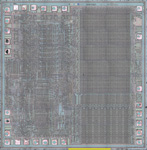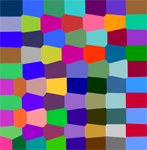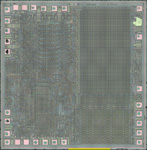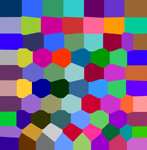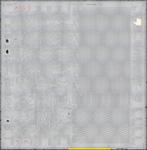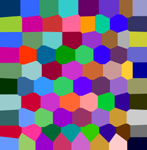


The Apple Lisa uses an interesting chip labeled "341-0064A (C) Apple." This controls the keyboard, mouse, RTC, and soft power switch. It's actually a National Semiconductor COP421 from the "COPS" family, customized for Apple. This makes it a difficult chip to replace and emulate, so it's worth extracting a gate-level accurate model
http://doc.chipfind.ru/pdf/nsc/cop421.pdf.
http://blog.modernmechanix.com/2008/05/29/a-behind-the-scenes-look-at-the-development-of-apples-lisa
http://www.1000bit.it/support/schema/apple/lisa/Lisa_1_Sys_IO.pdf
http://lisa.sunder.net/LisaProjectDocs.txt
Thanks to Michael Steil, we retrieved a chip from a non-functional Lisa board and exposed the silicon die in February, 2011. In time, we hope to capture and simulate many of the Lisa chips.
The image above is of the bare die after de-packaging. A map of the stitched images is on the right. The image below was taken after our special metal removal process which leaves outlines of the metal in the top glass passivization layer. There are a small number of metal patches remaining on the chip.
The ROM section of this chip is particularly interesting as very little documentation is available. Here's a full resolution image of the ROM. Transistors are slightly lighter in this image than the regions where there is no connection (where the tabs are cut), so we can read the ROM contents.
Below is an image of the bare substrate. This shows the connected ROM tabs clearly, but unlike other chips we've studied, the area of diffusion covered by polysilicon is not recessed. After removing polysilicon, the diffusion regions appear to be cut into separate small regions instead of having narrow lines connecting them where the borders of diffusion overlapped by polysilicon used to be. Still, we can figure out the ROM contents from the small bumps in the diffusion that stretch out slightly toward the vias on the output bit lines.
The topmost die shot is stitched from 73 separate microscope shots taken with a Nikon LV150 using an LU Plan Fluor 20x objective. The images were shot by Greg James in San Francisco, then corrected and stitched automatically by Christian Sattler in the UK using Autopano-sift-C and custom code. The final substrate image was produced on April 4, 2011.
The 6800 x 6918 images above are aligned with one another, so the features are easier to figure out by flipping between images. These are reduced resolution versions of the full die shots. The full size shots are about 9200 x 9350 pixels.
If you enjoy these images and our work, please consider a donation to further this work. We're a small group of enthusiasts who devote our free time and money to preserve computer technology. Your support is a valuable contribution to computer history and to preserving classic computer hardware in the public domain.
